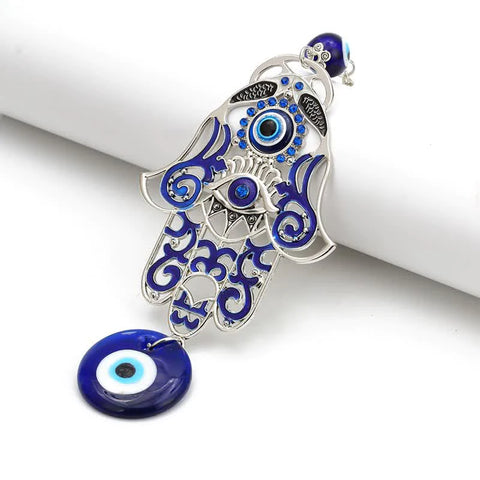Hamsa : The All-Seeing Hand of Protection and Blessings
This passage will guide you at:
-
Understanding Hamsa
-
Origins of the Hamsa
-
Meaning of Hamsa
-
The All-Seeing Hand: A Powerful Talisman Across Cultures
-
The Hamsa in Buddhism
-
Hamsa Hand Meaning Christianity
-
Choosing the Right Hamsa
-
Embracing the Hamsa
Text Leading
-
Ever wondered about the story behind the mesmerizing Hamsa hand you often see in jewelry and art?
-
What ancient secrets does this all-seeing symbol hold?
-
How has it crossed cultural boundaries to become a beloved emblem of protection and blessings?
Dive into the fascinating world of the Hamsa, from its deep historical roots to its significant meanings across different cultures. Discover how this powerful talisman can bring positive energies into your life and how to choose the right Hamsa that resonates with your spirit. Let's explore the enchanting allure of the Hamsa and how it continues to be a source of comfort and inspiration for many.
Understanding Hamsa
The Hamsa, also known as the Hand of Fatima or Hand of Miriam, is a captivating symbol with a rich history and profound significance. Its presence can be found in various cultures and religions, each offering their interpretation of its meaning and power.
The Universal Appeal of the Hamsa
Found across an array of cultures, the Hamsa carries varying interpretations, each adding layers to its profound symbolism. Its open hand symbolizes openness and hospitality, offering a welcoming gesture of peace and friendship.
The Hamsa in Daily Life
Whether adorned as jewelry, placed in homes as decor, or used in meditation and spiritual practices, the Hamsa serves as a constant reminder of the presence of protection and the potential for blessings that surround us.
In this blog, we delve into the origins of the Hamsa, explore its symbolism across different belief systems, and discover how it can be embraced as a source of protection and blessings in our daily lives.
Origins of the Hamsa
The Hamsa's origins can be traced back to ancient time. Its widespread adoption demonstrates the enduring appeal and universal resonance of the Hamsa.
Ancient Beginnings of Hamsa
The Hamsa traces its roots to ancient Mesopotamia, symbolizing the hand of a supreme deity. Initially, it represented divine protection and guidance. This symbolism laid the foundation for its deep spiritual significance.
Evolution of Hamsa
As the symbol spread to North Africa and the Middle East, it took on new meanings. Each culture adapted the Hamsa, incorporating it into their own spiritual practices. This adaptability shows Hamsa's universal appeal.
A Symbol of Hamsa
The widespread adoption of the Hamsa across various cultures highlights its enduring appeal. It has come to represent not just protection but also blessings, strength, and power. The Hamsa's journey from ancient times to the present day underscores its significance as a symbol with deep, ancient roots.
Meaning of Hamsa
Central to the Hamsa's symbolism is its association with protection against the evil eye, a belief shared by various cultures.
The hand-shaped talisman is thought to ward off negative energies, providing a shield of defense for those who possess it.
Additionally, By embracing the Hamsa, individuals seek to invite positivity into their lives while safeguarding themselves from harm.
Hamsa: A Shield Against Negative Energies
-
The Hamsa symbolizes protection, especially from the evil eye.
-
It's used in jewelry and home décor as a guardian against negativity.
Incorporating symbols like eyes or fish into Hamsa designs is not just an aesthetic choice; these elements have deep cultural roots in protecting individuals from harm.
The eye, often placed in the center of the Hamsa, is believed to reflect malicious intent back to the sender, while fish, symbolizing fertility and life in many traditions, are thought to distract the evil eye, ensuring the wearer’s safety and well-being.
Hamsa: Harbinger of Blessings
-
The Hamsa represents blessings, abundance, and good fortune.
-
It's believed to attract positive energies into one's life.
Floral patterns and motifs of flowing water frequently adorn the Hamsa, each adding layers of meaning to the symbol.
Flowers, with their natural beauty and growth, represent the blossoming of good fortune and joy in a person’s life.
Flowing water, on the other hand, signifies the continuous flow of prosperity and purity, cleansing away obstacles and bringing in a fresh tide of opportunities and blessings.
Hamsa and Prosperity
-
Linked to wealth and success, the Hamsa encourages financial stability.
-
It's placed in businesses to foster prosperity.
The addition of coins and wheat to the Hamsa's design goes beyond mere decoration.
Coins, with their obvious association with money and wealth, are a direct symbol of prosperity.
Wheat, a universal symbol of fertility and abundance, reflects the hope for a bountiful harvest—metaphorically speaking, a successful and profitable endeavor.
Together, these symbols amplify the Hamsa’s ability to attract material success, making it a powerful talisman for anyone seeking to enhance their financial situation.
Hamsa: Cultivating Positivity
-
Owning or gifting a Hamsa promotes a positive environment.
-
Its presence encourages peace and good vibes.
Lotus flowers and doves, when paired with the Hamsa, enrich its significance.
The lotus, emerging pristine from murky waters, symbolizes purity of heart and mind, spiritual awakening, and the triumph over obstacles.
Doves, universally recognized as messengers of peace and love, complement the Hamsa's protective qualities by inviting serenity and harmony.
This combination is a potent reminder of the wearer’s or the space’s dedication to fostering an atmosphere of tranquility and positive energy.
The All-Seeing Hand: A Powerful Talisman Across Cultures
One of the most intriguing aspects of the Hamsa is its all-seeing nature.
The eye depicted in the center of the palm symbolizes divine watchfulness, omniscience, and spiritual awareness.
This concept resonates across multiple cultures, from the Eye of Horus in ancient Egypt to the Third Eye in Hinduism and Buddhism.
The Hamsa's all-seeing hand serves as a constant reminder to stay mindful and connected to the spiritual realm.
The Hamsa in Buddhism
In Buddhism, the Hamsa is often combined with the Dharma Wheel. This symbolizes the Buddha's teachings and the path to enlightenment. The fusion represents the integration of protection with spiritual wisdom.
Symbolic Harmony in Buddhism
-
The Hamsa's protective qualities blend with Buddhist beliefs.
-
It signifies compassion and wisdom on the spiritual path.
-
Buddhists view the Hamsa as a guardian that embodies the essence of their teachings.
The Hamsa as a Protective Amulet
-
Buddhists adopt the Hamsa as a protective symbol.
-
It unites the powers of compassion and wisdom.
Integrating the Hamsa with the Dharma Wheel in jewelry or decor not only creates a visually stunning piece but also imbues it with deep spiritual significance.
This combination serves as a daily reminder of the path to enlightenment, emphasizing the importance of both external protection and internal growth.
When paired with the protective and compassionate energies of the Hamsa, it forms a powerful talisman that supports the wearer's journey towards enlightenment, fostering a sense of peace and determination to overcome obstacles.
Hamsa Hand Meaning Christianity
Here's a more detailed breakdown of the content regarding the Hamsa hand's meaning in Christianity:
-
Adoption by Christian Communities:
This adoption signifies an openness to integrating symbols from other cultures and religions that share a common value of protection and divine guardianship.
-
Symbolism of God's Hand:
In Christian interpretation, the Hamsa is seen as representing the hand of God. It's considered a reminder of God's omnipresence and his constant care and guidance for his followers.
-
Metaphorical Significance of the Five Fingers:
The five fingers of the Hamsa hand can be metaphorically linked to significant Christian and Jewish teachings. For Christians, they might represent the Five Wounds of Christ, symbolizing sacrifice and redemption.
-
Bridge Among Abrahamic Religions:
The Hamsa hand serves as a symbol of the shared heritage and values among the Abrahamic religions—Christianity, Judaism, and Islam.
-
Transcending Religious Boundaries:
The Hamsa hand's widespread recognition and respect across various religions highlight its ability to transcend religious and cultural boundaries.
Choosing the Right Hamsa
The Hamsa carries its unique symbolism and aesthetic appeal. Understanding the different elements, such as color, materials, and additional motifs, can guide the selection process, ensuring the chosen Hamsa aligns with one's intentions and preferences.
Hamsa Design Varieties
-
The Hamsa comes in diverse designs, each with unique symbolism.
-
Options range from silver pendants to ceramic wall hangings.
-
Every variation offers a distinct aesthetic and spiritual meaning.
Personal Resonance with Hamsa
-
Choosing a Hamsa involves finding a design that speaks to you.
-
It's about aligning the Hamsa with personal intentions and tastes.
-
The right Hamsa feels like a natural extension of the wearer's spirit.
Understanding Hamsa's Elements
-
Different elements like color and material add layers of meaning.
-
Silver may symbolize purity and clarity, while ceramics reflect earthiness.
-
Additional motifs, such as the eye or fish, enhance its protective energies.
Selecting the perfect Hamsa is a deeply personal journey. It's not just about the physical appearance but also the underlying symbolism and the energy it carries.
For instance, a Hamsa in blue might be chosen for its calming properties, representing water and sky, while a red Hamsa could be selected for its association with courage and protection.
Materials too play a significant role; a wooden Hamsa might connect one to nature and growth, whereas a metal one could signify strength and resilience.
Furthermore, motifs like the eye are believed to offer protection from the evil eye, and incorporating natural elements or specific symbols can tailor the Hamsa to individual spiritual needs or decorative preferences.
Thus, understanding these nuances ensures the Hamsa chosen is not only visually appealing but also a powerful personal amulet.
Embracing the Hamsa: Invoking Positive Energies in Daily Life
Integrating the Hamsa in Daily Settings
The Hamsa serves as more than just decoration; it enhances daily life. Positioning a Hamsa in the home or office can ward off negative energies. Its presence acts as a shield, promoting a safe and peaceful environment.
The Hamsa as a Reminder of Protection
Using the Hamsa as part of personal accessories keeps its protection close. It serves as a constant reminder of strength and blessings throughout the day. Wearing a Hamsa can instill a sense of security and calm in challenging situations.
Harnessing the Hamsa's Positive Energy
-
Focusing on the Hamsa during meditation can elevate one’s sense of peace.
-
It helps to manifest the Hamsa’s protective and blessing properties.
-
Regular interaction with the Hamsa strengthens its positive influence on one's life.
Embracing the Hamsa in daily practices doesn't just invite positive energies but also cultivates a lifestyle centered around mindfulness and protection. For instance, placing a Hamsa at the entrance of a home not only serves as a beautiful greeting to guests but also symbolizes a sanctuary safe from external negativity.
Similarly, incorporating the Hamsa into meditation routines can deepen the connection to its symbolism, enhancing personal tranquility and spiritual protection. Through these practices, the Hamsa becomes a vital part of one's journey towards a balanced and harmonious life, continuously offering its blessings and guard against the unseen.
Conclusion
The Hamsa is a captivating symbol of protection and blessings that transcends cultural and religious boundaries. Its origins date back to ancient times, and its all-seeing hand represents spiritual awareness and divine watchfulness. By embracing the Hamsa in our daily lives, we invite its positive energies and safeguarding influences. Whether it is through wearing Hamsa jewelry, incorporating it into home decor, or simply reflecting on its symbolism, the Hamsa serves as a powerful reminder to stay mindful and connected to the spiritual realm. May the Hamsa guide and bless us on our journey, providing us with the protection and abundance we seek.










